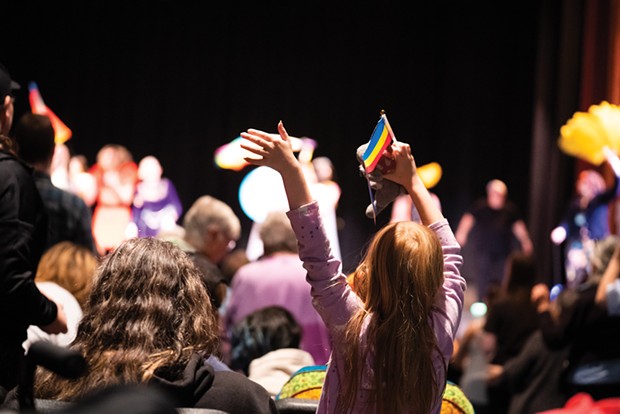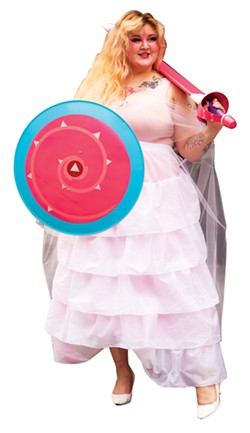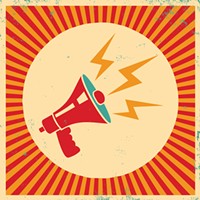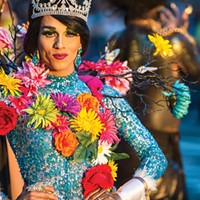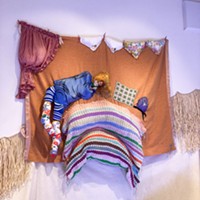Drag for the Next Generation
Why all-ages drag shows go on despite backlash
By Jennifer Fumiko Cahill [email protected] @jfumikocahill[
{
"name": "Top Stories Video Pair",
"insertPoint": "7",
"component": "17087298",
"parentWrapperClass": "fdn-ads-inline-content-block",
"requiredCountToDisplay": "1"
}
]
Dressed as a fairy princess in a purple gown and pointed ears, the drag performer known as Tucker Noir spoke in a bedtime story voice, telling the kids and grownups in the College of the Redwoods auditorium, "First there was clothing, then there was drag." As the words got bigger, she kept the Mother Goose tone. "Drag is the artistic and experimental exploration of gender," she explained. "I identify as a girl, whatever that means," she added, drawing laughter from the kids. "Drag is just dressing up for performance; everybody gets to do it."
Dragging Through Time, the family-friendly drag fundraiser for Lost Coast Pride, originally planned for January at the Old Steeple in Ferndale but canceled due to safety concerns, finally took place at CR April 29. After Felix Flex danced with a candy-colored sword and shield as Rose Quartz from the Steven Universe cartoon, and Aiden Abet and Uncle Histamine did a number from Monsters Inc., Noir returned to the stage. She was still an elf, but with pants and a five o'clock shadow. "The outfit I was wearing earlier would be fine in Tennessee but the one I'm wearing now is a felony ... just because I put the eyeshadow on the bottom part of my face." It was a wild thought to hang onto watching her perch in an oversized yellow wing chair as she led a sing-along to "The Rainbow Connection."
The right-wing media-fueled national furor over drag and kids has led to showdowns with extremist protesters, some armed, disrupting drag queen story hours and all-ages drag events. Locally, protesters and activists have shouted and attempted to intimidate participants, and branded drag event organizers and performers "groomers" out to lure and sexually abuse children. Despite the backlash and the genuine fear it can instill, local performers say they are determined to keep entertaining audiences of all ages in wigs, beards and fanciful costumes. For some of them, drag is both playful self-expression and a vital practice for their community, a sacred space to form connections and keep traditions alive.
Drag performance has a long tradition in America, going back to Vaudeville and masquerade balls. However, men playing women on stage is a tradition dating back to ancient Greek drama, Chinese opera, Japanese kabuki and Shakespearean plays (including those roles where a female character dresses as a man — try to keep up). The flashy, often bawdy style drag we see at clubs and on television grew out of LGBTQ+ communities in the 1980s. At its core, drag by kings, queens and artists exaggerates and plays with gender norms with art, humor, dance, drama, music, makeup and costume. Like other forms of theater, its range and audience are broad.
"Drag is about breaking down what society thinks of you and making yourself into whatever you want — it's imagination, it's playing," says Paul Michael Leonardo Atienza who teaches in the Critical Race, Gender and Sexuality Studies department at Cal Poly Humboldt. Atienza himself has a drag persona — Maria Arte Susya Turisima Tolentino, or Ma Arte — and performs on occasion at Los Angeles' long-running community open mic Tues Night Café. Ma Arte is an example of the alchemy of drag, born of the trauma of being teased. "There was so much shame for having feminine traits, my voice being higher than some of the boys, my walk having a little swish, always playing with the girls." These things felt natural to him but were considered wrong in his family. Then, during a retreat, Atienza, who'd already been into theater and performance, participated in an exercise that asked what would happen if you let go of shame. And Ma Arte, a glamorous "over-the-top Filipina" who leaned hard into all those supposedly shameful traits, was born.
"Drag gave me the chance to practice walking into a room like a confident person," says Noir. "It gave me the chance to think that I might not be gross and ugly," she adds with a laugh, "and I might not have felt that no matter how many people told me ... until I got there myself and it rewired my synapses." It also gave her a sense of community she missed from the conservative Christian life she led before she says speaking out about a sexual predator left her socially shunned. "I found that the tender core that I loved about church and the tender core of what I love about drag is the same," Noir says. "They've provided the kind of love and support that a church might," including helping each other with meals, chores, picking up outgrown clothes from one family and shuttling them to another. She also found an acceptance that had been missing in her former life. "I didn't even identify as queer when I started. ... Because the drag community loved and supported me as a straight married lady, I was able to grow."
Like church, Noir says it's also a chance for "coming together regularly to hear inspiring messages." She describes the thrill of seeing an audience awash with joy and acceptance as when performer Britney Shears, in sequined sneakers and a wig of blond curls, lip synced to Kesha's "Praying" at the CR show. At the line, "I'm proud of who I am," the room roared to life, and when she mimed hitting the song's dramatic high note, the kids and adults alike in the room cheered as if she was singing live. Shears was all in, her body language and features creating a cathartic emotional authenticity, if not an auditory one. Sometimes, says Noir, who sees parallels between drag performance and a sermon, "You just need a guide ... to guide you through the hike of that emotional experience."
The 16-year-old drag novice who goes by Brain R0t and only participates in all-ages shows, draws satisfaction from his young audience. "I love seeing children 5 to 10 and I see the sparkle in their faces when they see me perform and they jump out of their seats ... mainly the toddlers — it's so cute." And out of their seats they leapt when he filled the stage with teen crush angst in a neo-grunge floral dress. He says he thinks they respond to seeing a younger person performing, "and in their brains they're like, 'Oh, a kid is doing this so it must be safe and OK.'" He says performers are careful to avoid songs with swearing or references to drugs, alcohol or other adult topics. "We're just trying to keep the all-ages community as clean as possible."
Brain R0t first saw local performer Komboujia at an all-ages show and immediately wanted to try it. Since debuting in October of 2022, he's done a dozen and has found drag to be an outlet. "When I have emotion, I express it very loudly and very dramatically," he says, and picks a song that speaks to the feeling. "And I just put my all into it." Unlike theater, which he's also involved in, there are no pre-show jitters. "I think because with drag, if I wanted to, I could just improv." His drag persona's backstory speaks to all those elements: "He was a circus clown that has been reincarnated into a 16 year old's body," he says. "He's very sassy but he's very caring and if someone's upset, he will be there to help."
Komboujia, who also performed at the CR event as a goth space princess from the future assuring everyone we're going to be great, has filled the role of "drag mother," mentoring and offering advice to build Brain R0t's confidence and polish his performance. Brain R0t's own family has been supportive, as well. He says his mother has been to a number of shows and sometimes, "She goes backstage and helps the performers with costumes." While live shows are a bit loud for his father, Dad enjoys the videos posted online later.
Kaelan "Papa K" Rivera, founder of Lost Coast Pride, suited up as the pot-bellied Disney warthog Pumbaa and hammed it up for a duet of "Hakuna Matata" with Diamond in the Storm as Timon the meerkat to the delight of the youngsters waving tiny rainbow flags in CR's auditorium. The day was, he says, "Just tremendous outpouring and to have so many people [for whom] that was their first time, it just made me feel phenomenal ... just a ginormous feeling of the community coming together."
Still, the event and the months leading up to it were not carefree. "The risk is actually to the organizers and the performers," says Rivera. "CR did a huge, huge job with this and I'm forever grateful, and I hope we can do it again in the future. But now my picture is out there. ... It's the risk of putting yourself out there and the potential for harm." LCP's original family-friendly show at the Old Steeple was, after all, canceled due to safety concerns after the St. Mark's Lutheran Church in Ferndale put out a sign telling people to "Beware" of the event.
Cheery as Noir seems onstage, she worries about safety. "Anytime you're doing drag, you're aware of the present risk ... in the last five to nine months, it has really become to where ... I have to question as a mother if this is something I have the right to be doing. Do I have the right to take their mother and put her in these heightened situations?" She worries, too, about other performers and even audience members.
Noir says it's a consideration that event organizers look at before every drag show — Lost Coast Pride's adults-only fundraiser at Ferndale Repertory Theatre was the first drag show in Ferndale and the first time the theater used metal detectors at the door. The threat of violence in the comments on an online anti-drag petition sharpened those concerns. "Somehow that was concluded that was trolling," she says, noting the meaninglessness of the distinction. "The reality is that I had to go into producing that show knowing there were people with intention to do damage ... people going in with a lot of hate." She was pleased performers got to meet with CR police a week beforehand for a rundown of the security plan and that officers were focused on protecting them. Still, Noir says, she went on stage thinking, "'I don't think anybody is going to get shot here today,' but I didn't know until it was over."
Atienza says stigma around drag has always been there but "more recent developments in politics have reinvigorated these debates and it's also coming from the attack on trans people," amid confusion and conflation of drag, gender identity and sexuality. He attributes some of the panic to "fear of losing a type of 'normal' society that they're used to and targeting people that don't belong in those norms." But those conventions are not necessarily a given everywhere, as he teaches his students at CPH. "In our class, we think about the categories that are placed [on people] by colonialism. ... There were so many different beliefs and types of gender," he notes. "People with complex gender identities were important to society," sometimes as a bridge to the supernatural.
"There's a lot of rhetoric about, 'You're sexualizing our kids,'" says Atienza, who wonders in response, "Like, have you talked to your kids?" He points out plenty of heteronormative sexualization goes unnoticed in daily life. "Aren't we sexualizing our kids by asking them if they have a boyfriend or girlfriend in school?" And when it comes to accusations of "grooming," he says, "There's a lot of misinformation coming from our silos of media consumption."
The data simply doesn't support the scapegoating of LGBTQ+ people in general in regard to sexual abuse. A study at the Kempe Children's Center in Colorado examining 269 cases of sexual abuse found no link between homosexuality and abusers, concluding, "Those who molest children look and act just like everyone else. There are people who have or will sexually abuse children in churches, schools and youth sports leagues. Abusers can be neighbors, friends and family members. People who sexually abuse children can be found in families, schools, churches, recreation centers, youth sports leagues, and any other place children gather." It's a far broader and perhaps scarier profile than the fiction of one identifiable group as the source of danger. At least scarier for those outside that scapegoated population.
The anti-drag panic is blended with anti-transgender extremism, which frequently conflates the larger-than-life entertainment with everyday expression of gender identity and paints trans people as dangerous. According to the U.S. Department of Justice, however, trans people are actually disproportionately victimized. "Some reports estimate that transgender survivors may experience rates of sexual assault up to 66 percent, often coupled with physical assaults or abuse."
However, the hostility of recent anti-drag backlash hasn't deterred organizers and performers like Rivera. "This honestly is our future, it's being able to express yourself, to express what you feel," he says. "Brain R0t is a beautiful example ... [his performance] was entertainment, it wasn't this bawdy kind of adult theme. ... To have somebody in their teens able to express themselves," is worth everything to Rivera. "Being able to see that and know that it's OK, know that they have a safe space, ... that's drag shows and that's having a community center and being able to connect."
Rivera, who is a trans man, says he performed as a drag king in the late 1990s in Redding before transitioning. "What helped me was that I was getting more and more comfortable doing that and expressing parts of myself that I never had before."
For him, family-friendly drag shows are a way to share a legacy and coping tools with the next generation. "As a trans elder, it's important that we pass down how we struggled and how we fought ... to be able to pass down those survival skills, those how-to-create-your-own-safe-space skills, how to be a part of an adopted family. Most of us have been rejected by our families," Rivera says. "It's painful. So having that adopted family that you connect with ... because they are expressing what you are feeling ... is so very important to everyone. But especially to kids." Events for all ages, he says, are "how we do it. This is how we take care of our community."
Noir feels a similar sense of mission. "If we don't do it, then we are doing a disservice. We are somebody's history. If we don't make a place for this, it will wash it away. And people won't have the ministry that they need," she says. "There's such a wide variety of human experience and emotions ... that someone in the crowd will say, 'That one's me!'"
Offstage, Noir is working with kids in a two-year drag and performance program funded by a California Arts Council grant. The hands-on workshop covers everything from sound engineering to onstage skills, costumes, set design and more. Drag, she says, has a lot to offer kids, some of which overlaps with theater in general, some of which is unique to drag. "Every bit of drag is about making a creative vision happen and nothing is going to go exactly as you planned," so there's a lot of creative problem solving. "We're so consent based, we develop strong language skills around boundaries, forgiveness and teamwork," as well as self-advocating. "When you think about it, they're the only legal group without self-representation," Noir says, and giving them decision-making power, knowing they'll be supported, is powerful. One of the biggest things, she says, is "Imagining all you could be ... and actually try[ing] it out."
That anti-drag hostility is on the rise as states are taking away trans rights and abortion rights is not a surprise to Atienza. "The right[s] to the choices of your own body are all connected. And the fear of drag is the history of the gay rights movement. Stonewall, the [Compton's] Cafeteria attack in San Francisco — these were all people who were... not wearing the clothing of their assigned gender and they were surveilled and attacked ... because of the power the authorities wanted to uphold." Ultimately, he says, "It's a losing battle."
Asked about the anti-drag backlash, Brain R0t says "I think that's a them-problem that they need to sort out and I can't solve it for them. But I think they need to look a little deeper and see what's behind their feelings about drag and all that." He says he felt unsafe at one show but handled it. "I immediately went inside and went to the first person I saw from the drag community and told them." That person, he says, asked the man to leave, as he was scaring kids.
At the start of Dragging Through Time, Noir told the audience, "Some of you right here in this room might not feel good about drag. And I want to say I'm glad you're here and I love you." She says a few people have told her they brought guests who were initially unsure about whether drag was safe for kids and that the welcome mattered. Those audience members are important to Noir, too, and partly why she started out dressed as a girl, gradually moving toward a male costume. She talks about "planting seeds" that can grow into acceptance. "I was a conservative Christian and very anti-gay," she says. "The seeds that people planted took a long time."
For performers like Noir, drag isn't just about entertainment, it's about a powerful shared experience of joy and acceptance among performers, the audience and a community fighting for survival. "Unabashed and unconditional love — we're down for that and it's hard to not feel."
Jennifer Fumiko Cahill (she/her) is the arts and features editor at the Journal. Reach her at (707) 442-1400, extension 320, or [email protected]. Follow her on Instagram @JFumikoCahill and on Mastodon @jenniferfumikocahill.
Speaking of...
Comments (6)
Showing 1-6 of 6
more from the author
-
What's Good
New Digs for Il Forno and Obento
- Jul 11, 2024
-
Maxxxine's Bloody Point
- Jul 11, 2024
-
Il Forno in Fortuna
- Jul 8, 2024
- More »
Latest in News
Readers also liked…
-
Through Mark Larson's Lens
A local photographer's favorite images of 2022 in Humboldt
- Jan 5, 2023
-
'To Celebrate Our Sovereignty'
Yurok Tribe to host gathering honoring 'ultimate river warrior' on the anniversary of the U.S. Supreme Court ruling that changed everything
- Jun 8, 2023
